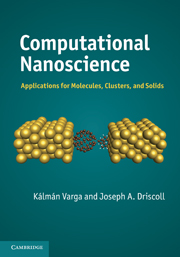Book contents
- Frontmatter
- Contents
- Preface
- Part I One-dimensional problems
- Part II Two- and three-dimensional systems
- 7 Three-dimensional real-space approach: from quantum dots to Bose–Einstein condensates
- 8 Variational calculations in two dimensions: quantum dots
- 9 Variational calculations in three dimensions: atoms and molecules
- 10 Monte Carlo calculations
- 11 Molecular dynamics simulations
- 12 Tight-binding approach to electronic structure calculations
- 13 Plane wave density functional calculations
- 14 Density functional calculations with atomic orbitals
- 15 Real-space density functional calculations
- 16 Time-dependent density functional calculations
- 17 Scattering and transport in nanostructures
- 18 Numerical linear algebra
- Appendix: Code descriptions
- References
- Index
11 - Molecular dynamics simulations
from Part II - Two- and three-dimensional systems
Published online by Cambridge University Press: 05 June 2012
- Frontmatter
- Contents
- Preface
- Part I One-dimensional problems
- Part II Two- and three-dimensional systems
- 7 Three-dimensional real-space approach: from quantum dots to Bose–Einstein condensates
- 8 Variational calculations in two dimensions: quantum dots
- 9 Variational calculations in three dimensions: atoms and molecules
- 10 Monte Carlo calculations
- 11 Molecular dynamics simulations
- 12 Tight-binding approach to electronic structure calculations
- 13 Plane wave density functional calculations
- 14 Density functional calculations with atomic orbitals
- 15 Real-space density functional calculations
- 16 Time-dependent density functional calculations
- 17 Scattering and transport in nanostructures
- 18 Numerical linear algebra
- Appendix: Code descriptions
- References
- Index
Summary
Molecular dynamics simulation is one of the most fundamental tools of materials modeling. Such simulations are used to study chemical reactions, fluid flow, phase transitions, droplet formation, and many other physical and chemical phenomena. Many textbook and review articles [119, 263, 96, 5, 113] exist in the literature, and in this chapter we restrict ourselves to a basic introduction.
Classical molecular dynamics uses Newton's equations of motion to describe the time development of a system. These calculations involve a long series of time steps, at each of which Newton's laws are used to determine the new positions and velocities from the old positions and velocities. The computation is simple but has to be repeated many times. For accurate simulation the time step is very small and the calculation takes a long time to simulate a real time interval. The force calculation in an N-particle system may scale as O(N2), thus the calculation time can be quite long. In the last few decades sophisticated computational algorithms have been developed to address these problems. In this chapter we study two prototypical examples of MD simulations: the Lennard–Jones system and structure of Si described by the Stillinger–Weber potential [299].
Introduction
Classical molecular dynamics (MD) uses potentials based on empirical data or on independent electronic structure calculations. It is a powerful tool for investigating many-body condensed matter systems.
- Type
- Chapter
- Information
- Computational NanoscienceApplications for Molecules, Clusters, and Solids, pp. 263 - 273Publisher: Cambridge University PressPrint publication year: 2011



